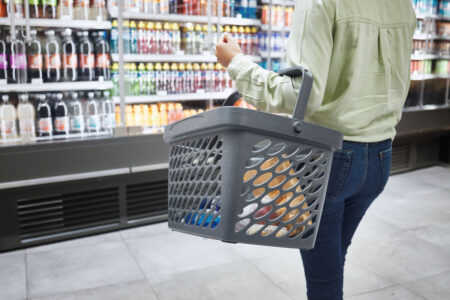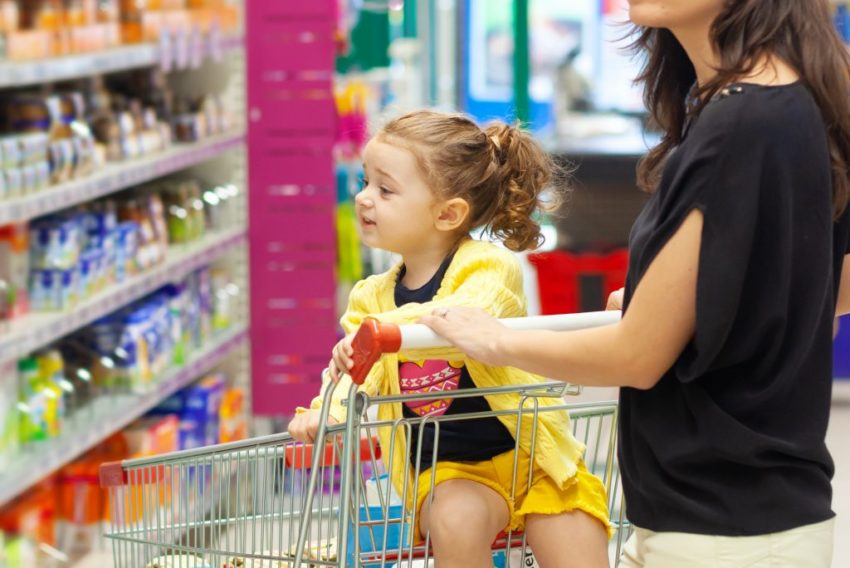
Share On Social!
Nearly 2 of 3 U.S. children’s drinks sold in 2018 were unhealthy fruit drinks and flavored waters with added sugars and/or diet sweeteners, according to Children’s Drink FACTS 2019, a new report from the Rudd Center for Food Policy & Obesity.
In fact, none of the 34 top-selling children’s sugary drinks met expert recommendations for healthy drinks for children.
These unhealthy drink sales complicate health equity for Latino and black children, who are targeted more with sugary drink marketing and have higher rates of sugary drink consumption. They face obesity, higher rates of cavities (57% of all Latino kids have cavities), and other health conditions as a result.
“Beverage companies have said they want to be part of the solution to childhood obesity, but they continue to market sugar-sweetened children’s drinks directly to young children on TV and through packages designed to get their attention in the store,” said Dr. Jennifer L. Harris of Rudd Center in a statement.
The Facts Behind Sugary Drinks
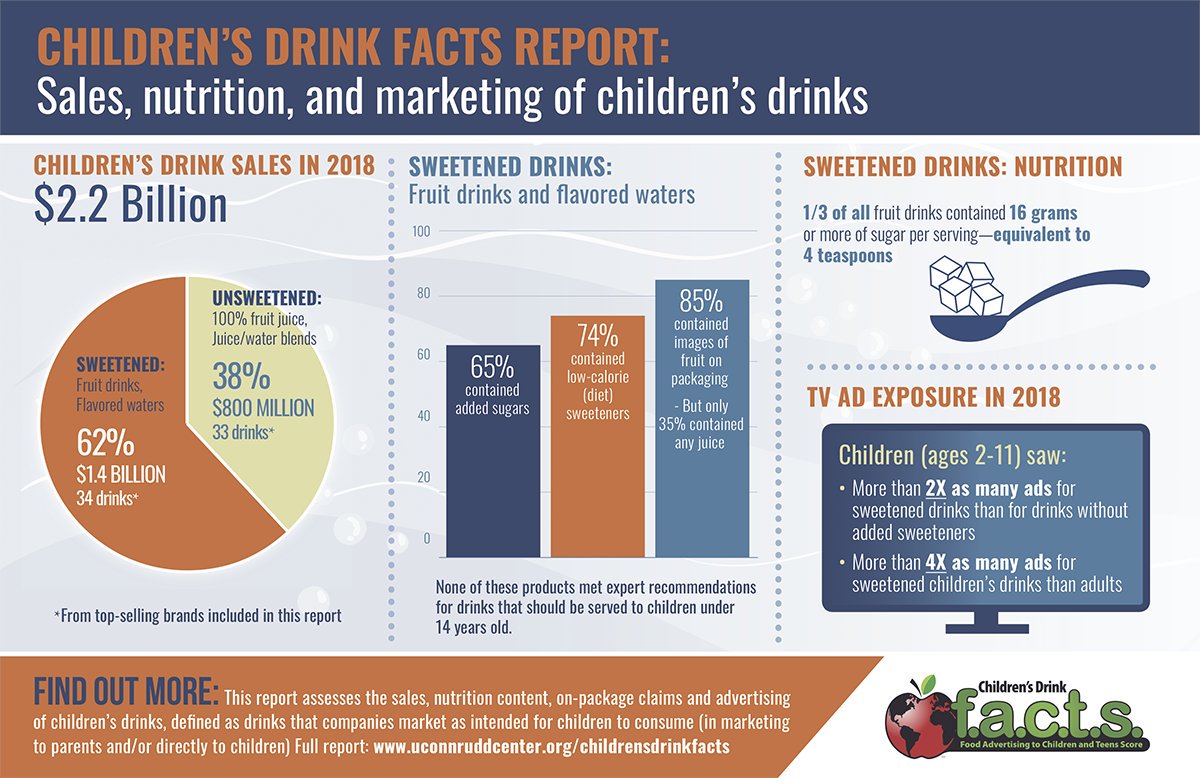 Rudd Center’s new Children’s Drink FACTS 2019 report assesses the sales, nutritional content and packaging, and marketing of brands of children’s drinks. It also compares the new data to earlier reports from 2010 and 2014.
Rudd Center’s new Children’s Drink FACTS 2019 report assesses the sales, nutritional content and packaging, and marketing of brands of children’s drinks. It also compares the new data to earlier reports from 2010 and 2014.
The findings are alarming.
- One-third of all children’s fruit drinks contained 16 grams or more of sugar per serving—equivalent to 4 teaspoons, which is more than half of the maximum amount of added sugars experts recommend for children per day.
- Sugary drinks made up 62% of the $2.2 billion in total U.S. children’s drink sales in 2018. Healthier drinks, such as 100% juice, represented just 38% of children’s drink sales
- Companies spent $20.7 million to advertise children’s drinks with added sugars in 2018, primarily to kids under age 12.
The analysis also found that TV advertising of sweetened drinks targeted Black and Latino children, including Spanish-language TV.
Even though this targeted marketing isn’t a new discovery, it reinforces that marketing continues to disproportionately target Black and Hispanic youth. These trends are also seen in advertising that parents see.
When are We Going to See Change in Sugary Drinks?
Some signs point to hope for the future.
Companies marketed only three children’s drinks on Spanish-language TV in 2018, according to Rudd Center’s report.
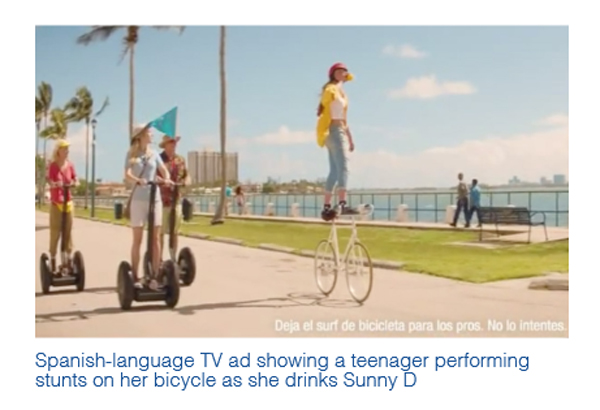 Other than Capri Sun and Sunny D, “no other drink brand in any of the categories examined (including non-children’s products) advertised on Spanish-language TV in 2018.”
Other than Capri Sun and Sunny D, “no other drink brand in any of the categories examined (including non-children’s products) advertised on Spanish-language TV in 2018.”
Still, this emphasizes the need for strong advertising regulations.
The Children’s Food and Beverage Advertising Initiative (CFBAI) is an industry voluntary self-regulatory program. Many companies—Coca Cola, Burger King, McDonalds, Hershey, Pepsico, and more—have joined CFBAI and have agreed to only market 100% juice, water, and milk-based drinks to children under 12. Also, CFBAI will update its nutrition criteria by January 2020.
But Sunny D’s parent company, Harvest Hill Beverage Company, does not participate in CFBAI.
“Capri Sun Refreshers juice/water blend also spent a small amount (approximately $100,000) to advertise on Spanish-language TV,” according to the report. “However, no other brands in the categories examined in this report (including other, not children’s, brands) advertised on Spanish-language TV in 2018.”
So, change is happening. But there are still more ads for unhealthy sugary drinks than there are advertisements for healthy drinks that appear to target Latino and black children.
How Is Sugary Drinks Marketing Impacting Latino Families?
The statistics in the Children’s Drinks Facts 2019 show multiple opportunities for improvements both marketing and nutritional value.
Drink packages often are confusing.
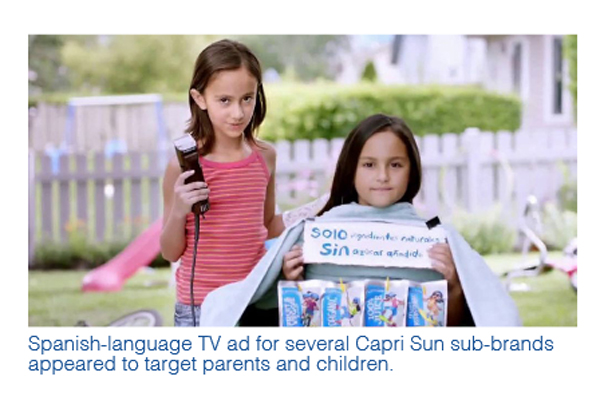 For example, sugary fruit drinks typically contain less than 5% juice or less. But 80% of those packages included images of fruit and 60% claimed to have “less” or “low” sugar or “no high fructose corn syrup,” according to Rudd Center’s report.
For example, sugary fruit drinks typically contain less than 5% juice or less. But 80% of those packages included images of fruit and 60% claimed to have “less” or “low” sugar or “no high fructose corn syrup,” according to Rudd Center’s report.
Other phrases, such as “gluten free,” “low-carb,” and “all natural,” can lead parents into making quick assumptions without reading the full nutrition facts label. These phrases may seem credible to the average person trying get the best for their children.
Sometimes parents simply don’t realize just how unhealthy sweetened drinks are for their children.
“You shouldn’t have to be a nutritionist to figure out whether or not a product is healthy for your child,” said Dr. Maria Romo-Palafox of Saint Louis University in a statement.
“The fronts of the packages make children’s drinks look healthy, but there’s no way to know which ones have added sugars or low-calorie sweeteners reading the front. You have to read the nutrition facts panel on the back and you have to know the names of low-calorie sweeteners,such as acesulfame potassium and sucralose,to realize they are in the product.”
How Can I Help Reduce Sugary Drinks?
Rudd Center’s report has a few recommendations:
- Beverage manufacturers, retailers, and media companies should do more to ensure that drinks marketed for children are healthy options.
- Federal regulation and state and local actions could also encourage selection of healthier drink options for children. This includes front-of-package nutritional labeling on added sugars, and banning images of fruits on drinks with little or no fruit juice.
- Pediatricians and advocates should continue to push policy to reduce sugary drink consumption among children. For example, here are 5 policy recommendations supported by the American Academy of Pediatrics (AAP) and the American Heart Association (AHA).
Our Salud America! research review also found several emerging solutions:
- Raise the price of sugary drinks. A 10% increase in sugary drink prices can reduce consumption by up to 12.1%.
- Reduce access to sugary drinks in childcare centers. Few early childcare centers report serving sugary drinks to kids ages 0-5. But increased regulation can reduce serving of sugary drinks and increase promotion of water.
Salud America! also created an Action Pack to help school leaders push for Water Bottle Fountains in schools to boost access to water for Latino and all kids.
ADD A WATER BOTTLE FOUNTAIN IN YOUR SCHOOL!
Explore More:
WaterBy The Numbers
74
percent
of Latino kids have had a sugary drink by age 2 (vs. 45% of white kids)


